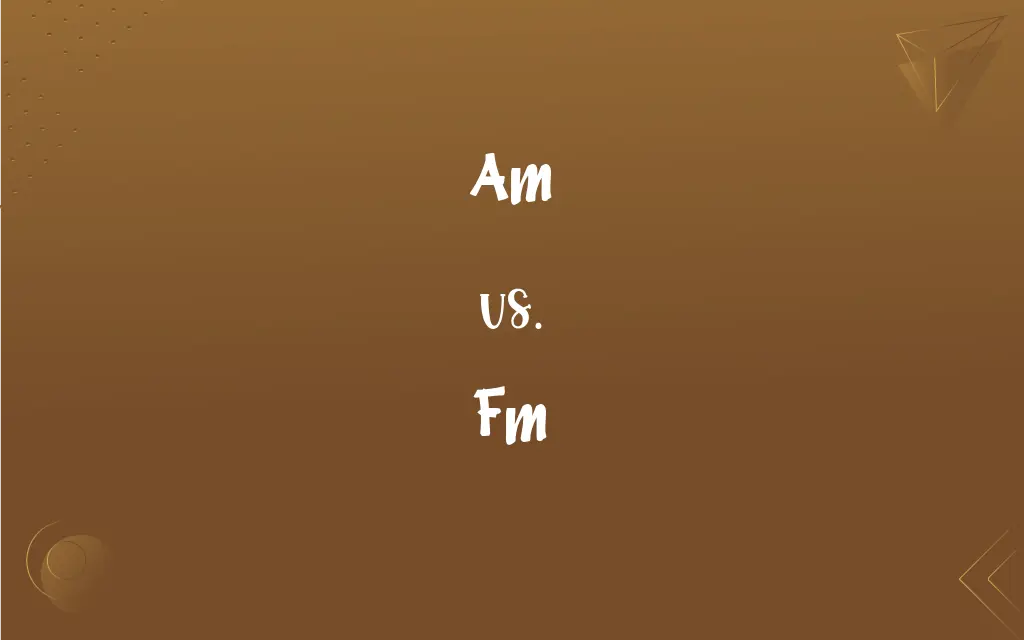AM vs. FM: What's the Difference?
Edited by Aimie Carlson || By Harlon Moss || Updated on October 9, 2023
AM (Amplitude Modulation) varies signal amplitude; FM (Frequency Modulation) varies signal frequency.

Key Differences
AM, or Amplitude Modulation, modifies the amplitude (or height) of a carrier wave to transmit information. FM, or Frequency Modulation, on the other hand, alters the frequency (or distance between waves) of the carrier wave to convey information.
In AM radio broadcasting, the strength of the signal fluctuates to represent the audio information, but its frequency remains constant. Conversely, in FM radio, the amplitude remains steady, but the frequency changes according to the audio information.
AM radio tends to have a longer range compared to FM. However, FM generally provides a clearer sound quality than AM. This is because FM is less susceptible to interference from electrical equipment and atmospheric conditions than AM.
While both AM and FM are utilized for broadcasting, AM is more commonly affected by interference during nighttime, due to the ionospheric reflection of the radio waves. FM, however, is more resistant to such interference, offering consistent quality regardless of the time of day.
Given the inherent qualities of AM and FM, AM is often used for talk radio stations, while FM is preferred for music stations. This distinction is due to the better fidelity and lesser noise interference that FM offers, making music sound clearer.
ADVERTISEMENT
Comparison Chart
Modulation Type
Varies amplitude
Varies frequency
Sound Quality
Generally lower
Clearer and higher
Range
Typically longer
Shorter but stronger
Interference
More susceptible (especially at night)
Less susceptible
Common Use
Talk radio
Music stations
ADVERTISEMENT
AM and FM Definitions
Am
Abbreviation for asset management.
The firm specializes in AM for high net worth individuals.
Fm
Abbreviation for "Federated States of Micronesia".
He visited FM for a research project.
Am
A reference to time, denoting "ante meridiem" or before midday.
The meeting is at 10 am.
Fm
Abbreviation for Facilities Management.
The FM team is handling the building repairs.
Am
A method of transmitting radio signals by varying amplitude.
My radio receives AM frequencies.
Fm
Short for frequency modulation in electronics and signal processing.
The device uses FM synthesis.
Am
Short for Associate Member.
She is an AM of the organization.
Fm
A method of transmitting radio signals by varying frequency.
My favorite station is on FM.
Am
A verb used to denote the first person singular of "be".
I am going to the store.
Fm
Abbreviation for Field Manual in military context.
The soldier referred to the FM for guidelines.
FAQs
What does AM stand for in time?
AM stands for "ante meridiem" or before midday.
Why is FM often used for music stations?
FM provides clearer sound quality ideal for music.
Are AM radio waves affected at nighttime?
Yes, AM can experience more interference at night.
How is FM different from AM in radio transmission?
FM varies frequency, while AM varies amplitude.
Can AM signals travel farther than FM signals?
Generally, AM signals have a longer range than FM.
What does FM stand for in radio broadcasting?
FM stands for Frequency Modulation.
What part of the day does "am" denote in time?
"am" denotes the time before midday or noon.
Is "am" a verb?
Yes, "am" is the first person singular of "be".
Why might one choose an AM station over FM?
AM stations often have talk radio or can be received at longer distances.
Which is older: AM or FM radio broadcasting?
AM broadcasting predates FM.
What does FM stand for in military terms?
In a military context, FM can stand for Field Manual.
Can "am" and "fm" refer to memberships or statuses?
Yes, "am" can refer to Associate Member, and "fm" might be used in specific contexts, though not as commonly for membership status.
What does FM mean in the context of countries?
FM can stand for "Federated States of Micronesia".
In what context is "am" used to refer to asset management?
In finance, AM can be an abbreviation for asset management.
Why is FM less susceptible to interference?
FM's modulation of frequency makes it more resistant to certain types of interference than AM.
Do all radios receive both AM and FM signals?
Most modern radios can receive both, but some might be limited to one or the other.
Is FM only used for radio broadcasting?
No, FM also refers to frequency modulation in electronics and other contexts.
Is the word "am" always capitalized when referring to time?
Typically, "am" is written in lowercase when denoting time, but style guides may vary.
Do FM signals provide better sound quality?
Generally, FM offers clearer and higher sound quality than AM.
How does interference affect AM and FM?
AM is more susceptible to interference, especially at night, compared to FM.
About Author
Written by
Harlon MossHarlon is a seasoned quality moderator and accomplished content writer for Difference Wiki. An alumnus of the prestigious University of California, he earned his degree in Computer Science. Leveraging his academic background, Harlon brings a meticulous and informed perspective to his work, ensuring content accuracy and excellence.
Edited by
Aimie CarlsonAimie Carlson, holding a master's degree in English literature, is a fervent English language enthusiast. She lends her writing talents to Difference Wiki, a prominent website that specializes in comparisons, offering readers insightful analyses that both captivate and inform.































































